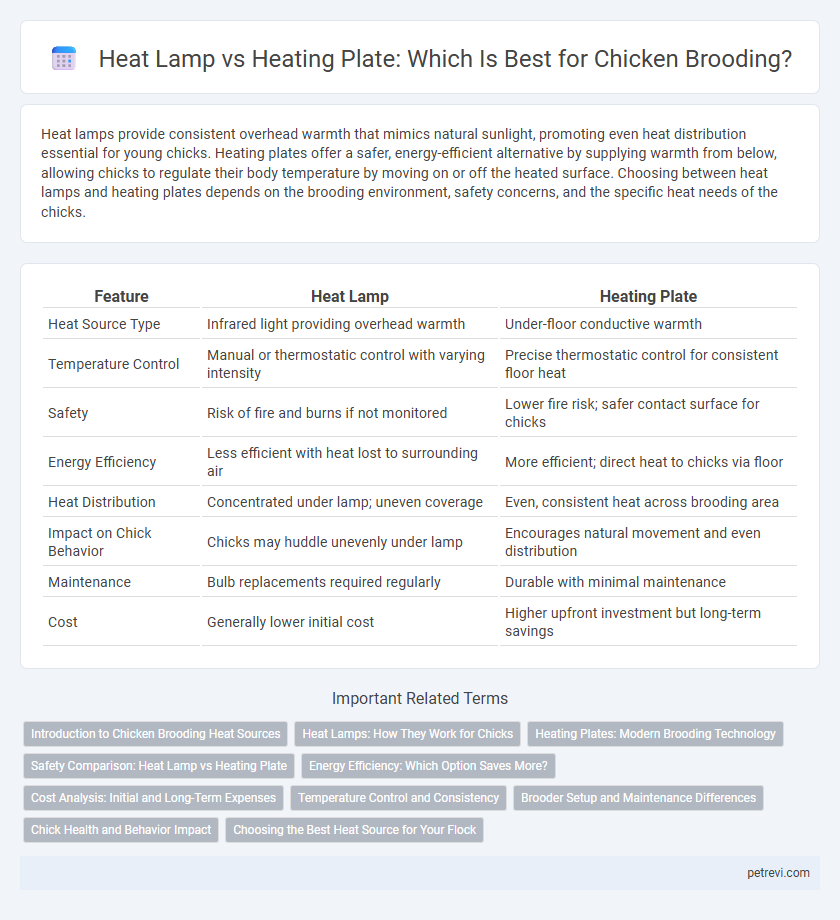Heat lamps provide consistent overhead warmth that mimics natural sunlight, promoting even heat distribution essential for young chicks. Heating plates offer a safer, energy-efficient alternative by supplying warmth from below, allowing chicks to regulate their body temperature by moving on or off the heated surface. Choosing between heat lamps and heating plates depends on the brooding environment, safety concerns, and the specific heat needs of the chicks.
Table of Comparison
| Feature | Heat Lamp | Heating Plate |
|---|---|---|
| Heat Source Type | Infrared light providing overhead warmth | Under-floor conductive warmth |
| Temperature Control | Manual or thermostatic control with varying intensity | Precise thermostatic control for consistent floor heat |
| Safety | Risk of fire and burns if not monitored | Lower fire risk; safer contact surface for chicks |
| Energy Efficiency | Less efficient with heat lost to surrounding air | More efficient; direct heat to chicks via floor |
| Heat Distribution | Concentrated under lamp; uneven coverage | Even, consistent heat across brooding area |
| Impact on Chick Behavior | Chicks may huddle unevenly under lamp | Encourages natural movement and even distribution |
| Maintenance | Bulb replacements required regularly | Durable with minimal maintenance |
| Cost | Generally lower initial cost | Higher upfront investment but long-term savings |
Introduction to Chicken Brooding Heat Sources
Chicken brooding requires consistent warmth, with heat lamps and heating plates being popular heat sources. Heat lamps provide radiant heat from above, mimicking the natural warmth of a mother hen, while heating plates offer a safe and energy-efficient alternative by supplying heat from below. Choosing the right heat source impacts chick comfort, growth rates, and energy consumption during the critical brooding phase.
Heat Lamps: How They Work for Chicks
Heat lamps provide consistent infrared heat that mimics the warmth mother hens offer, crucial for maintaining optimal body temperature in chicks during brooding. These lamps emit radiant heat that warms both the chicks and their environment, promoting healthy growth and activity levels. Proper positioning and wattage selection of heat lamps ensure uniform heat distribution, preventing cold spots and reducing the risk of overheating.
Heating Plates: Modern Brooding Technology
Heating plates provide consistent ground warmth that mimics a mother hen's natural heat, improving chick comfort and reducing stress during brooding. This modern brooding technology enhances energy efficiency by focusing heat where chicks rest, resulting in lower electricity consumption compared to heat lamps. Heating plates also minimize fire hazards and excessive heat fluctuations, promoting healthier growth and reducing mortality rates in poultry farming.
Safety Comparison: Heat Lamp vs Heating Plate
Heat lamps pose a higher risk of fire hazards and burns due to exposed bulbs and elevated temperatures, making them less safe for chicken brooding. Heating plates provide a closed, low-temperature surface that reduces the likelihood of injury and accidental fires, offering a safer environment for chicks. Safety standards and proper installation are crucial for minimizing risks with either heat source in chicken brooding.
Energy Efficiency: Which Option Saves More?
Heat lamps consume significantly more electricity, typically ranging from 250 to 250 watts per hour, whereas heating plates operate efficiently at around 25 to 50 watts, making plates more energy-efficient for chicken brooding. The even heat distribution of heating plates reduces overall energy use by minimizing temperature fluctuations that cause chickens to move toward or away from the heat source, lowering heating demand. Optimizing brooder temperature with a heating plate not only cuts energy costs but also promotes healthier, more stable growth conditions for chicks.
Cost Analysis: Initial and Long-Term Expenses
Heat lamps for chicken brooding typically have a lower initial cost, ranging from $10 to $30, but consume more electricity, increasing long-term expenses. Heating plates, although priced higher initially between $40 and $70, offer energy-efficient, consistent warmth, reducing ongoing power bills. Over time, investing in a heating plate can lead to significant savings in operational costs compared to the frequent bulb replacements and higher energy usage of heat lamps.
Temperature Control and Consistency
Heat lamps provide adjustable temperature zones, allowing precise control over brooding heat but may cause uneven warmth distribution. Heating plates offer consistent, surface-level warmth that mimics a mother hen's body heat, promoting even temperature maintenance across the brooding area. For optimal chicken brooding, combining heat lamps with heating plates ensures stable and uniform temperature control, crucial for chick growth and health.
Brooder Setup and Maintenance Differences
Heat lamps and heating plates differ significantly in brooder setup and maintenance for chicken brooding. Heat lamps require secure hanging fixtures and regular bulb replacements to ensure consistent warmth and avoid fire hazards, while heating plates need stable placement on the brooder floor and periodic surface cleaning to prevent buildup and maintain effective heat transfer. Both systems demand monitoring of temperature gradients to promote chick health but differ in energy efficiency and ease of maintenance.
Chick Health and Behavior Impact
Heat lamps provide consistent warmth that mimics natural sunlight, promoting vigorous activity and proper feather development in chicks, but may cause uneven heat distribution leading to stress or overheating. Heating plates offer a controlled, evenly heated surface that encourages natural brooding behavior and reduces the risk of leg injuries and heat-related ailments by allowing chicks to self-regulate their temperature. Choosing between heat lamps and heating plates depends on the balance between uniform warmth and behavioral comfort, impacting overall chick health and growth performance.
Choosing the Best Heat Source for Your Flock
Heat lamps provide focused, adjustable warmth ideal for small broods, but pose fire risks and consume more electricity, making heating plates a safer, energy-efficient choice that mimics a mother hen's body heat for consistent warmth. Heating plates reduce stress on chicks by encouraging natural resting behavior underneath the plate and maintain an even temperature without hot spots. Selecting the best heat source depends on flock size, safety priorities, and energy costs, with heating plates favored for larger flocks and long-term brooding.
Heat Lamp vs Heating Plate for Chicken Brooding Infographic

 petrevi.com
petrevi.com